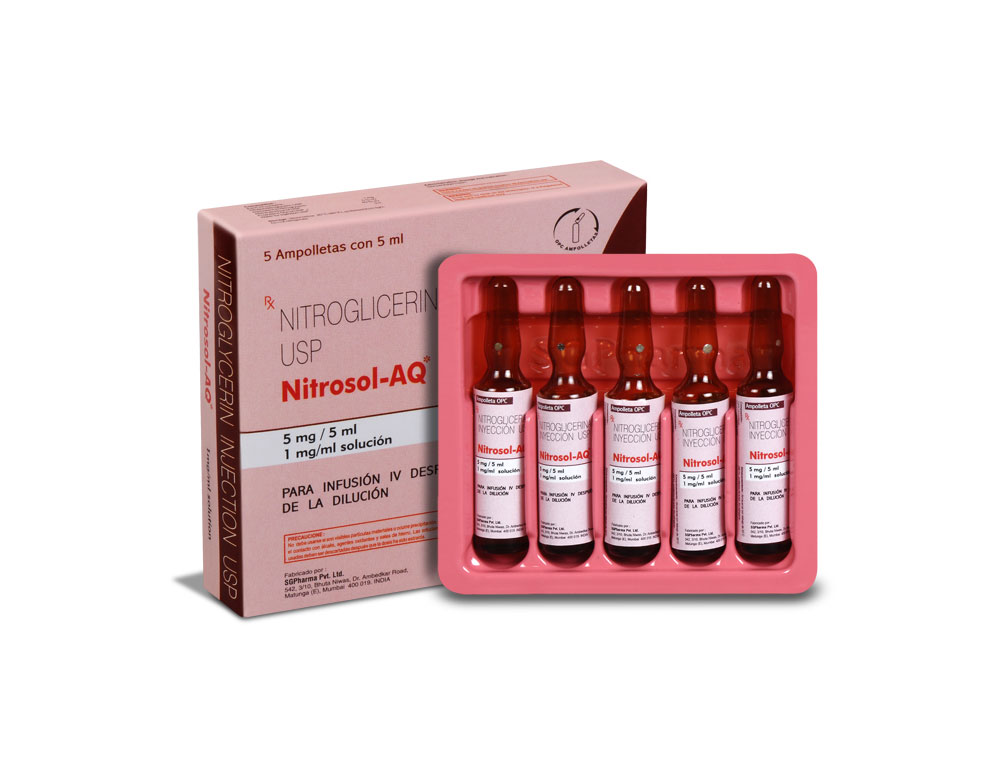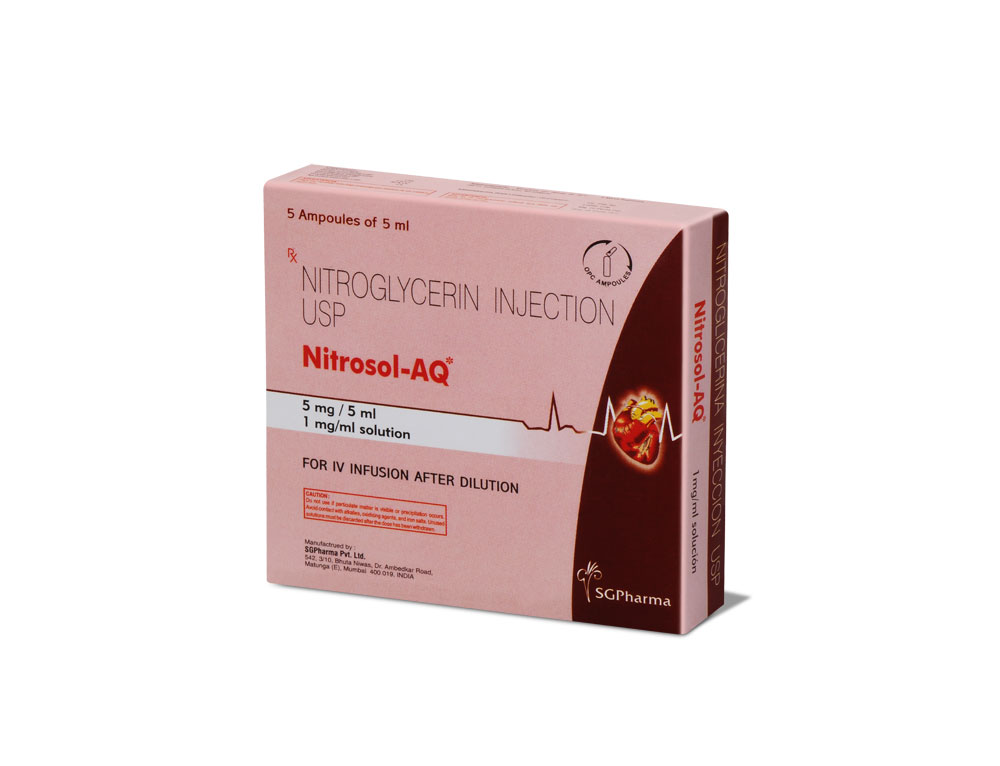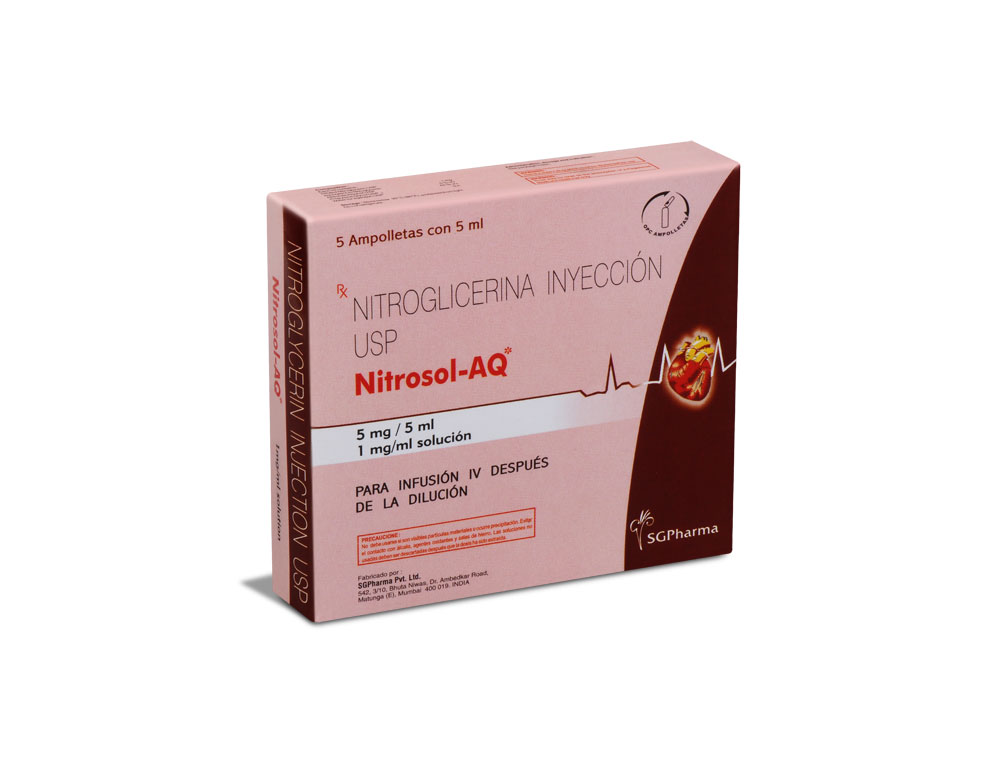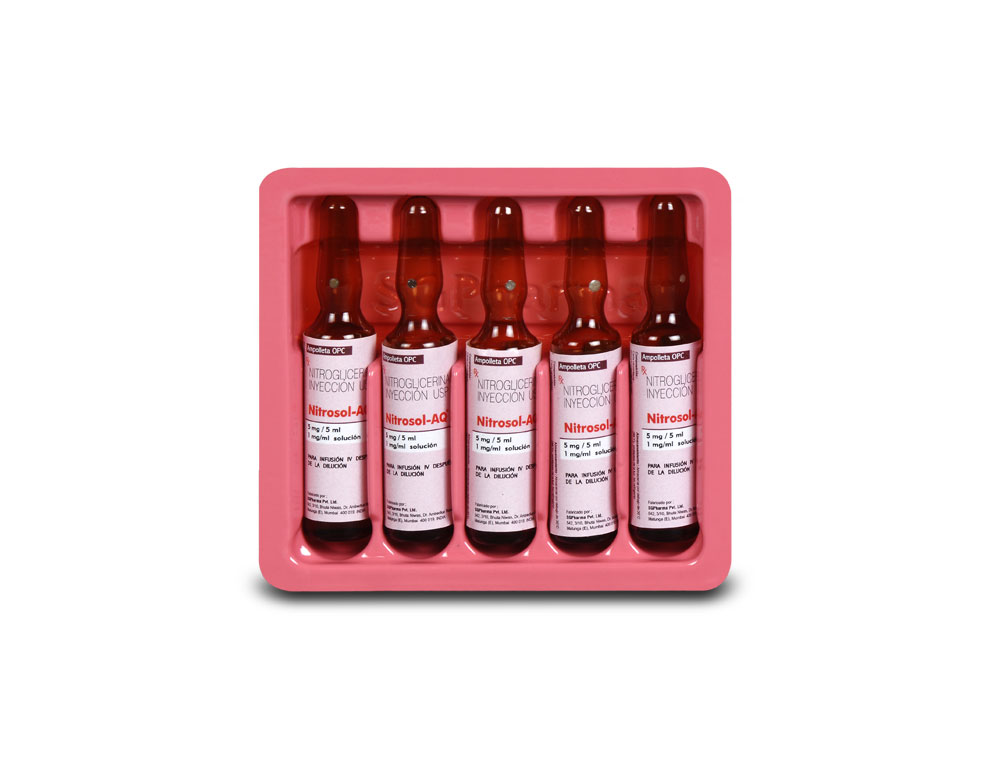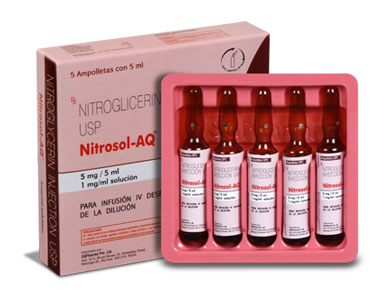
5 mg/5 ml
For the use of a Registered Medical Practitioner or a Hospital or a Institution only.
NITROSOL-AQ (Nitroglycerin) is an organic nitrate vasodilator, active on both arteries and veins. Chemically Nitroglycerin is 1,2,3 –propanetriol trinitrate. The molecular formula is C3H5N3O9 and the molecular weight is 227.09.
STRUCTURAL FORMULA :
Its structural formula is :
-Structure.jpg)
NITROSOL-AQ is a sterile, clear, practically colourless solution for intravenous infusion after dilution. The solution is sterile, nonpyrogenic and nonexplosive.
COMPOSITION :
Each ml contains :
Diluted Nitroglycerin USP
equivalent to Nitroglycerin 1 mg
Absolute Alcohol USP 5 % v/v
Propylene Glycol USP 40 % v/v
Water for Injection USP q.s.
Contains no preservatives.
ACTIONS :
Nitroglycerin, an organic nitrate, is a vasodilator. Its principal pharmacological action is the relaxation of vascular smooth muscle. Nitroglycerin produces, in a dose-related manner, dilation of both arterial and venous beds. Dilation of the post-capillary vessels, including large veins, promotes peripheral pooling of blood and decreases venous return to the heart reducing left ventricular end diastolic pressure (pre-load). Arteriolar relaxation reduces systemic vascular resistance and arterial pressure (after-load). Myocardial oxygen consumption or demand (as measured by the pressure rate product, tension time index and stroke work index) is decreased by both the arterial and venous effect of Nitroglycerin and a more favourable supply demand ratio can be achieved. Therapeutic doses of intravenous Nitroglycerin reduce systolic, diastolic and mean arterial blood pressure. Effective coronary perfusion pressure is usually maintained, but can be compromised if blood pressure falls excessively or increased heart rate decreases diastolic filling time.
Nitroglycerin reduces elevated central venous and pulmonary capillary wedge pressures, pulmonary vascular resistance and systemic vascular resistance. Heart rate is usually slightly increased, presumably a reflex response to the fall in blood pressure, Cardiac index may be increased, decreased or unchanged. Patients with elevated left ventricular fillings pressure and systemic vascular resistance values in conjunction with a depressed cardiac index are likely to experience an improvement in cardiac index. Alternatively, when filling pressures and cardiac index are normal, cardiac index may be slightly reduced by intravenous Nitroglycerin.
PHARMACOKINETICS :
Nitroglycerin is widely distributed in the body with an apparent volume of distribution of 200 l in adult male subjects. It is rapidly metabolised in the liver to dinitrates and mononitrates, with a short half life estimated at 1-4 minutes. This results in a low plasma concentration after intravenous infusion. At plasma concentrations of between 50 - 500 mg/ml, the binding of Nitroglycerin to plasma proteins is approximately 60 % while those of its metabolites, 1, 3-glyceryldinitrate and 1, 2-glyceryldinitrate are approximately 60 % and 30 % respectively. The activity and half-life of Dinitroglycerin metabolites are not well characterized. Glyceryl mononitrate, the principal metabolite, is inactive.
INDICATION :
NITROSOL-AQ permits rapid attainment of high concentration of drug in the systemic circulation and prompt initiation of therapy. Because of its rapid degradation, the concentration can be titrated quickly and safely.
NITROSOL-AQ is indicated for :
1.Control of blood pressure in pre-operative hypertension i.e. hypertension associated with surgical procedures, especially cardiovascular procedures such as hypertension during intra-tracheal intubation, anaesthesia, skin incisions, sternotomy, cardiac bypass and in immediate post-surgical period.
2.The treatment of congestive heart failure associated with acute myocardial infarction.
3.The treatment of angina pectoris in the patients who have not responded to the recommended doses of organic nitrates and/or a beta blocker, unstable angina pectoris and coronary vasospasm.
4.The production of controlled hypotension during surgical procedures.
Administration :
NITROSOL-AQ is for Intravenous use.
NITROSOL-AQ should be administered by means of a micro-drip set infusion pump or similar device which permits maintenance of constant infusion rate.
NITROSOL-AQ IS A CONCENTRATED POTENT DRUG WHICH MUST BE DILUTED IN 5 % DEXTROSE INJECTION USP OR 0.9 % SODIUM CHLORIDE INJECTION USP PRIOR TO ITS INFUSION.
NITROSOL-AQ SHOULD NOT BE ADMIXED WITH OTHER DRUGS.
INSTRUCTIONS FOR USE OF AMPOULE :
The ampoule used in this product is equipped with O.P.C (One Point Cut) opening system. No ampoule file is needed to open the ampoule. The neck of the ampoule is prescored at the point of constriction. A coloured dot on the ampoule head helps to orientate the ampoule. Take the ampoule and face the coloured dot. Let the solution at the head of the ampoule to flow down by shaking or a gentle stroke. The ampoule opens easily by placing the thumb on the coloured dot and gently pressing downwards as shown.

Dosage :
Initial Dilution :
Aseptically transfer the desired volume of NITROSOL-AQ (see the Dilution Table) into the glass bottle containing stated volume of either 5 % w/v Dextrose Injection or 0.9 % w/v Sodium Chloride Injection (Diluent Volume). This yields a final concentration of 50 to 200 microgram/ml (see the Dilution Table). Invert the glass parenteral bottle several times following admixture to assure uniform dilution of NITROSOL-AQ.
DILUTION TABLE
-Table.jpg)
Use in Pregnancy : Category C
No studies have been conducted. NITROSOL-AQ should be given to pregnant woman only if clearly needed.
Use in Lactation :
It is not known whether Nitroglycerin is excreted into breast milk. Caution should be exercised if there is a need to administer NITROSOL-AQ to a nursing woman.
Paediatric Use :
The use of NITROSOL-AQ in children is not recommended, as its safety and effectiveness in children have not been established.
INTERACTIONS AND INCOMPATIBILITY :
1.Alcohol : Concomitant use with Alcohol may cause hypotension due to enhanced vasodilatory effects of Nitroglycerin.
2.Other drugs : Information on potential interaction with other drugs is poorly documented. Caution should be observed if other drugs are given concomitantly during infusion of NITROSOL-AQ as an interaction may adversely affect the haemodynamic response to the drug. Careful haemodynamic monitoring is essential.
3.Pancuronium : Infusion of Nitroglycerin Injection increases the duration of Pancuronium induced neuromuscular blockade. This clinical observation has been reported by studies in the cat, however neuromuscular blockade induced by Succinylcholine and d-tubocurarine were not prolonged by Nitroglycerin. The mechanism of interaction is unknown.
4.Morphine : One patient who received four 3 mg doses of I.V. Morphine sulphate during 24 hour period with I.V. Nitroglycerin became unarousable, eventually responding to Nalorphin. The possibility that I.V. Nitroglycerin slows the Morphine metabolism in this patient has been suggested. Caution should be observed when administering these two drugs simultaneously.
5.Tricyclic antidepressants, anticholinergic drugs : Caution should be observed when giving tricyclic anti-depressants and anticholinergic drugs concomitantly with NITROSOL-AQ because these agents may potentiate the hypotensive effects of Nitroglycerin.
SIDE EFFECTS :
The most frequent possible side effect (natural, expected and unavoidable drug actions) in patients treated with NITROSOL-AQ is headache which occurs in approximately 2 % of patients. Other side effects (unusual, unexpected and infrequent reactions) occurring in less than 1 % patients are the following : tachycardia, nausea, vomiting, apprehension, restlessness, muscle twitching, retrosternal discomfort, palpitations, dizziness and abdominal plain.
OVERDOSAGES AND TREATMENT OF OVERDOSAGES :
Accidental overdosage of NITROSOL-AQ may result in severe hypotension and reflex tachycardia which can be treated by elevating the legs and decreasing or temporarily terminating the infusion until patient’s condition stabilises. Since the duration of hemodynamic effects following administration is quite short, additional corrective measures are usually not required. However, if further therapy is indicated, administration of an intravenous alphaadrenergic agonist (e.g. Methoxamine or Phenylephrine) should be considered. Infusions of plasma or suitable electrolyte solutions should also be considered.
PHARMACEUTICAL PRECAUTIONS :
NITROSOL-AQ ampoules are intended for single use only. Properly discard any unused portion. Parenteral drug products should be inspected visually for particulate matter and discoloration prior to administration, whenever solution and container permit.
STORAGE :
Store below 30°C (86°F), protected from light.
Do not refrigerate.
SHELF LIFE :
24 months from the date of manufacture.
PRESENTATION :
NITROSOL-AQ contains Diluted Nitroglycerin USP equivalent to Nitroglycerin 1 mg/ml solution.
5 Ampoules of 5 ml in a carton.

 Cardiovascular
Cardiovascular



